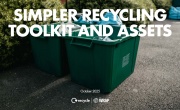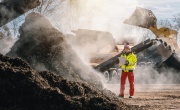Could caterpillars help solve the world’s plastic problem?
A common caterpillar could help unlock the solution to the world’s plastic bag dilemma, research has suggested.

Scientist Federica Bertocchini, who is also an avid beekeeper, happened upon this discovery when tending to her beehives, which were riddled with the parasitic wax worm. Greater wax moths tend to lay their eggs in beehives, for them to hatch and grow on the beeswax. During a routine removal of the worms from her hives, Bertocchini happened upon a startling discovery after placing the worms in a plastic bag – she noticed holes starting to appear in the bag.
Along with two other colleagues, she conducted a timed experiment, using 100 worms and a plastic bag from a UK supermarket. After 40 minutes of being exposed to the worms, holes had appeared in the bag, and after 12 hours there was a reduction of 92 milligrams (mg) in plastic mass from the bag.
According to the study, the degradation rate of plastic bags when exposed to the worms is extremely fast compared to results of recent studies at Kyoto University where plastic bags exposed to certain bacteria saw a reduction in plastic mass of just 0.13 mg in a day.
Paolo Bombelli, author of the study, said: “The caterpillars are not just eating the plastic without modifying its chemical make-up. We showed that the polymer chains in polyethylene plastic are actually broken by the wax worms.
"If a single enzyme is responsible for this chemical process, its reproduction on a large scale using biotechnological methods should be achievable."
Wax is like a ‘natural plastic’
Polyethylene accounts for 40 per cent of total demand for plastic products across Europe, with around a trillion plastic bags used around the world each year. It can take hundreds of years to biodegrade and often ends up on landfills or accumulating in rivers and oceans.
 In the 27 EU countries plus Norway and Switzerland, up to 38 per cent of plastic is sent to landfill, with 36 per cent being burnt for energy recovery, not including the material that leaks into the environment.
In the 27 EU countries plus Norway and Switzerland, up to 38 per cent of plastic is sent to landfill, with 36 per cent being burnt for energy recovery, not including the material that leaks into the environment.
Bertocchini noted that the wax that the worms usually feed on has a chemical structure similar to polyethylene, enabling them to break it down naturally, although this requires further investigation.
The team also smeared some mashed worms onto the bags, proving that the degradation results not just from the chewing action of the caterpillars, but something produced chemically in their gut or saliva. They conducted a spectroscopic analysis to show the chemical bonds in the plastic being broken by the worms, which convert the polyethylene into ethylene glycol, breaking the polymer chains.
The next step is for researchers to identify the molecular processes occurring in this reaction, to see if the knowledge can be used to develop a biotechnical solution which can be implemented on a wider scale to help manage plastic waste.
Bertocchini added: “We are planning to implement this finding into a viable way to get rid of plastic waste, working towards a solution to save our oceans, rivers, and all the environment from the unavoidable consequences of plastic accumulation”.
Results of the study have been published in the Current Biology journal, available online.











